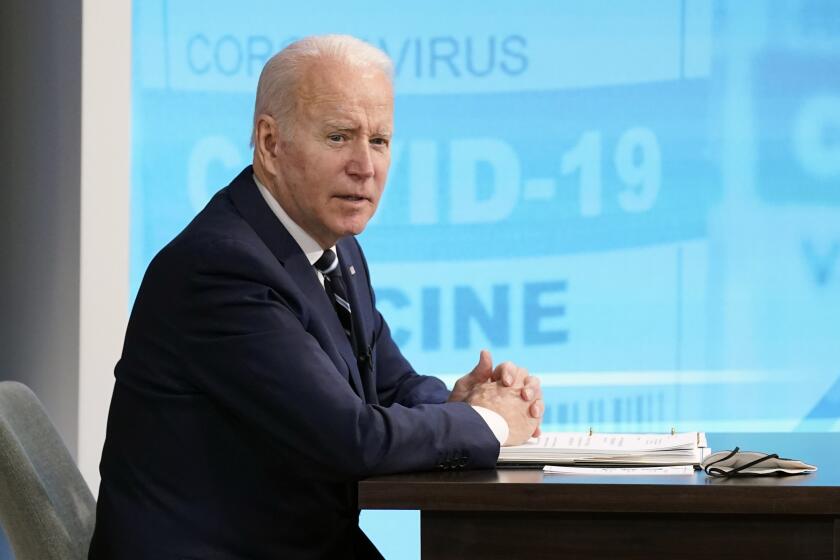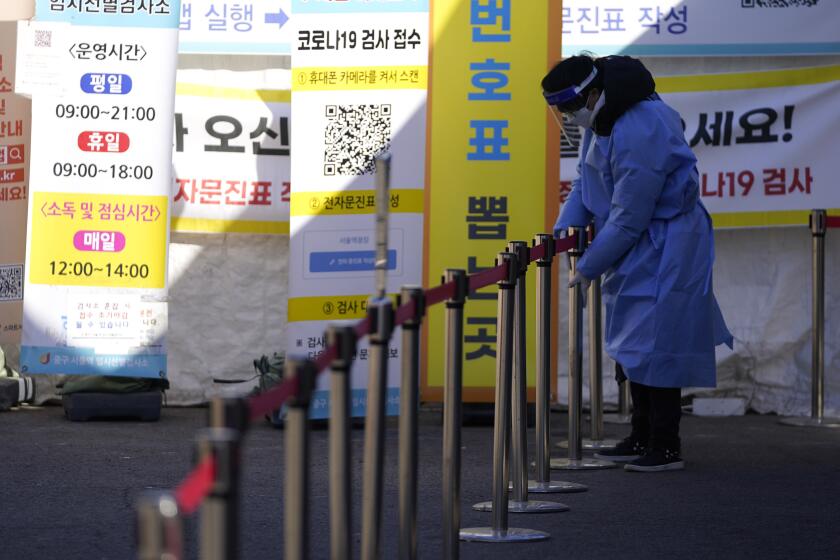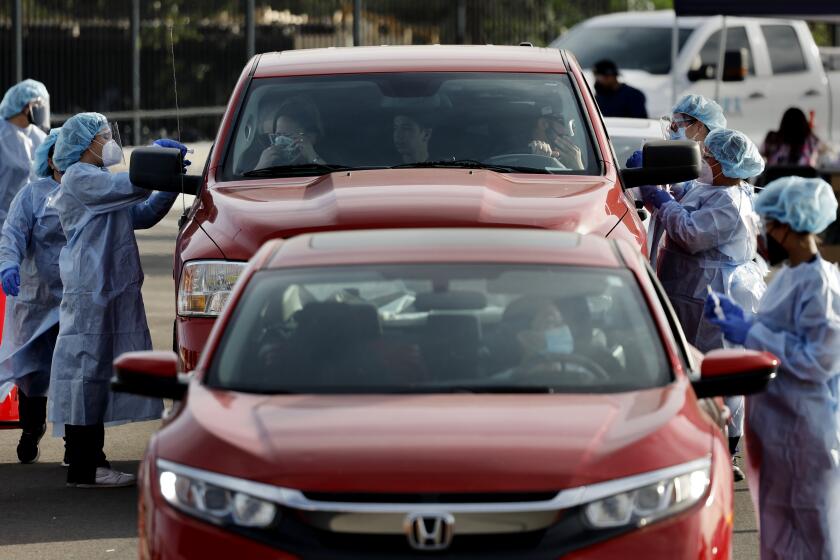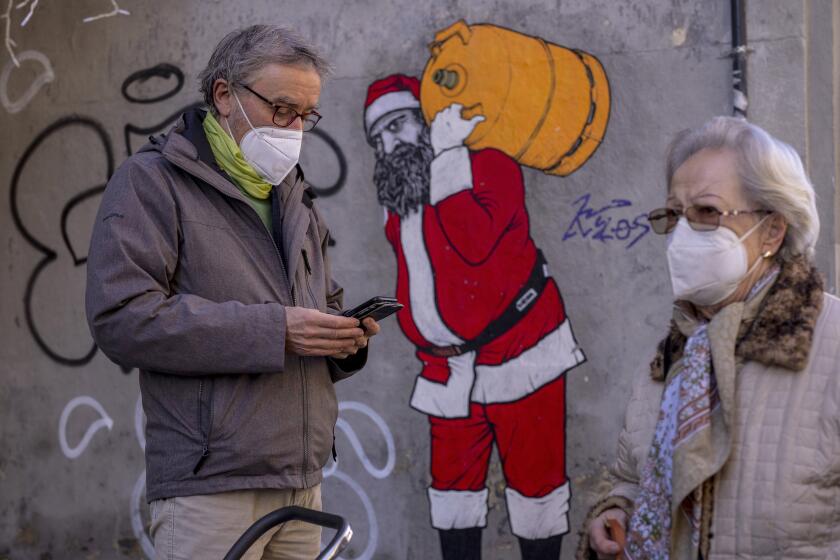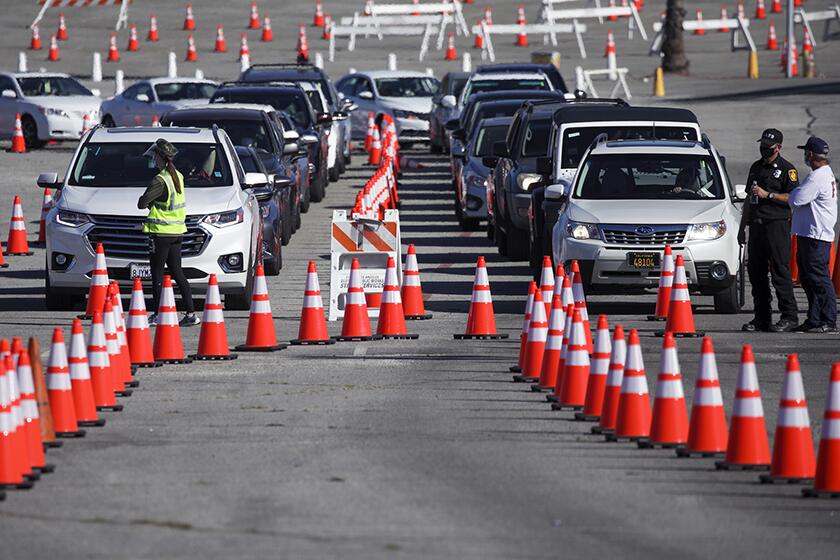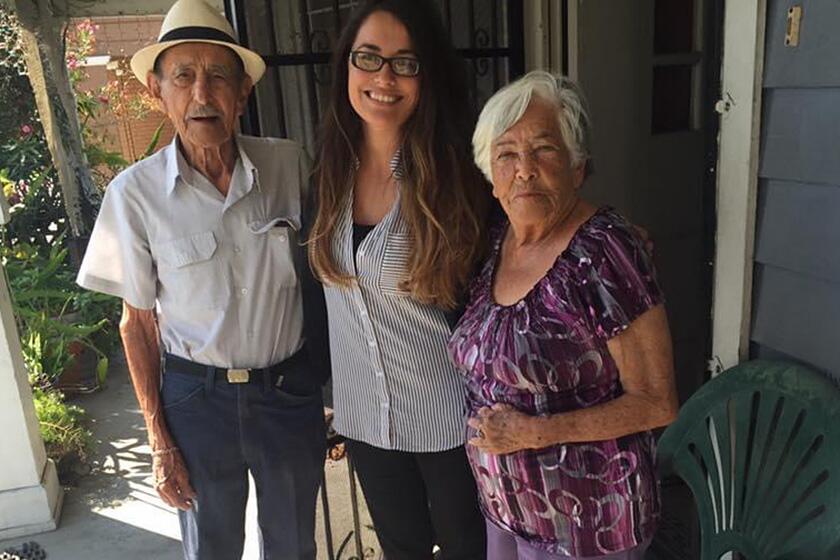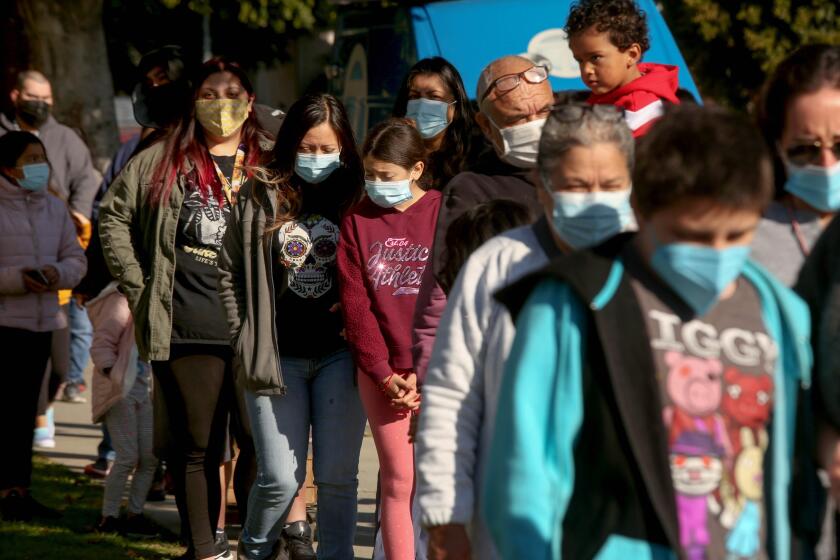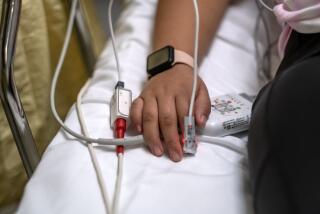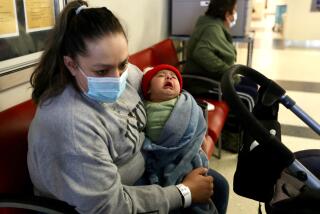Emergency rooms nearing ‘crisis levels’ in parts of California as Omicron surges

- Share via
Emergency rooms are nearing crisis levels in parts of California, and officials are forecasting weeks of strain in hospitals even as there are glimmers of hope the Omicron wave may soon peak in the northern part of the state.
There is unprecedented spread of the coronavirus in California; never before in the pandemic have so many people been simultaneously infected.
And despite signs that Omicron is less likely to require patients to need mechanical help to breathe, the extraordinarily high case rate — 2½ times last winter’s peak — is still leaving hospitals so inundated that scheduled surgeries are being canceled and ambulances are facing long delays dropping off patients.
“We are seeing near-crisis levels of [emergency department] overcrowding in certain areas,” Dr. Erica Pan, the state epidemiologist, said in a briefing to the California Medical Assn.
By midweek, California was reporting 52,400 hospitalizations for all reasons, just shy of the peak of 53,000 recorded at the height of last winter’s surge. L.A. County was also approaching its peak; on Thursday, it had about 15,000 people hospitalized for all reasons, approaching the pandemic high of nearly 16,500 set last winter, “when most hospitals were frankly overwhelmed,” said county Public Health Director Barbara Ferrer.
Overall demand for emergency care is “causing a huge stress on our emergency rooms,” Pan said. “With healthcare staffing shortages on the inpatient ward, it’s harder to admit patients. And if you don’t have enough nurses to take care of those patients, then there’s a lot of backlog in the [emergency department] as well.”
That then results in ambulances kept waiting in front of hospitals, delaying crews’ ability to respond to new 911 calls.
The White House plans to launch a website Wednesday where Americans can order a limited number of free, rapid coronavirus tests to be sent to their homes.
The rate of coronavirus spread is so astronomically fast that California could tally a million new coronavirus cases in about a week — the fastest such pace in the history of the pandemic. It was only on Monday that California surpassed 6 million total reported coronavirus cases, according to data compiled by The Times. With the state averaging 115,000 new cases a day over the last week, a feverish level of spread that’s unprecedented in the nearly two-year-old pandemic, California is on track to tally its 7 millionth within days.
Even during last winter’s surge, it still took three weeks to accumulate a million new cases, with the state peaking at 46,000 new infections a day.
Last winter, L.A. County peaked at 16,000 coronavirus cases a day; by Friday, it was tallying about 41,000 daily cases.
South Korea will slightly ease its COVID gathering restrictions but keep a 9 p.m. curfew as it braces for a possible Omicron surge.
Hospitals say they’re swamped with patients seeking care related to the coronavirus and the flu.
“Hospitals are full,” said Dr. Regina Chinsio-Kwong, a deputy health officer for Orange County, where many ambulances are waiting as long as 44 minutes to drop off patients once they arrive at emergency rooms, which is above the goal of 30 minutes.
Last week, about five of Orange County’s 25 hospitals were requesting more staffing from the state to help fill the gaps. Now, “more than half of our hospitals are experiencing significant staffing shortages and have also asked for assistance,” Chinsio-Kwong said.
The Los Angeles County emergency medical system is so challenged that the county has dispatched workers to monitor patients in emergency rooms so ambulances can be released faster to reduce worsening 911 response times.
“Ambulance companies who contract with [L.A. County] to provide emergency response through the 911 system have experienced severe staffing shortages and are having difficulty responding to calls in a timely manner,” said L.A. County Health Services Director Dr. Christina Ghaly.
The Dutch government has eased its coronavirus lockdown, allowing nonessential stores, universities, sports clubs and ‘contact businesses’ such as hairdressers to reopen for the first time in nearly a month.
On Thursday, there were about 4,257 coronavirus-positive patients hospitalized across L.A. County. That’s nearly five times higher than the patient count recorded on Christmas. L.A. County accounts for nearly a third of the 13,349 coronavirus-positive patients hospitalized statewide.
Demand for hospital care is so great that L.A. County and the state have established three surge hospital units, at Mission Community Hospital in Panorama City, Providence Little Company of Mary Medical Center in San Pedro and Antelope Valley Hospital in Lancaster. When fully staffed, they will add nearly 100 beds to L.A. County, including 33 intensive care unit beds.
In Northern California’s most populous county, Santa Clara, officials expressed hope that a peak in new cases was coming, noting reduced levels of coronavirus detected in its wastewater.
Some parts of the globe that saw Omicron explode are now seeing the wave recede or flatten. California is expected to follow soon.
Still, new cases and hospitalizations are increasing across the county that’s home to Silicon Valley. And because it takes weeks for newly infected people to get sick enough to need care in the hospital, the strain on hospitals is still expected to worsen for some weeks.
“We have learned that Omicron spreads like wildfire, and we know that many sectors, including healthcare, education and many other critical sectors, are experiencing a lot of staff shortages because of illness from Omicron,” said Dr. Sara Cody, the public health director and health officer for Santa Clara County.
Experts urged people to do all they can to avoid getting infected with the coronavirus, such as avoiding gatherings and wearing masks when around other people, practices that could curtail viral transmission that could threaten vulnerable family members and friends.
Unvaccinated people have the highest risk of being infected and becoming severely ill, but it’s also possible some vaccinated people, especially those who are elderly and who are vulnerable to COVID-19 complications, will get breakthrough infections and become severely ill.
The coming weeks will be “a bad time to be hospitalized,” said UC San Francisco infectious-diseases expert Dr. Peter Chin-Hong, “when California will be probably already in the middle of being bursted at the seams for increased hospitalization.”
Italy, Spain and other European countries are reinstating or stiffening mask mandates as their hospitals struggle with influx of COVID-19 patients.
Worsening matters is a national scarcity of donated blood. A blood shortage forced an hours-long closure of the trauma center at Harbor-UCLA Medical Center in West Carson on Monday, a step not taken there in more than three decades.
“California, along with the rest of the nation, is experiencing the most severe blood shortage in the last 10 years,” Dr. Mark Ghaly, California’s health and human services secretary, said in a statement Friday. “I encourage you to make an appointment to donate if you can and are eligible.”
The rippling effects of the overcrowded emergency rooms are resulting in hospitals canceling scheduled surgeries or procedures, which can worsen the outlook for patients who have been waiting for care for cancer and other conditions, when prompt treatment can make a difference.
Two years into the COVID-19 pandemic, we can be optimistic. But we can’t let our guard down.
While early studies have shown that, with more recent COVID-19 patients, there’s less of a need for an artificial oxygen supply or for them to be placed on a mechanical ventilator, “that’s not universally the case,” said Dr. Paul Simon, chief science officer for the L.A. County Department of Public Health.
“We have over 4,000 patients in the hospital with COVID. We think about maybe 40% of them were hospitalized for other reasons, but they happened to test positive for COVID upon admission. But then the remaining 60% are there for COVID-related illness, and we are seeing about 15% of the patients are in the intensive care unit,” Simon said.
There are some signs that Omicron may not be as harmless as some early data suggested. L.A. County is averaging about 27 COVID-19 deaths a day, up from 14 deaths a day a month earlier. L.A. County saw record daily death tallies for last autumn and this winter on Thursday, with 45 deaths, and on Friday, with 48 additional fatalities related to COVID-19.
Simon said about half the recent deaths were among people diagnosed with a coronavirus infection this month, when Omicron had become the dominant variant. “So it’s not that Omicron is completely harmless. It can cause severe disease in some people,” Simon said.
Lorenzo Arellano once vowed he’d never get vaccinated. But COVID affected too many unvaccinated people in his life for him to stick to backward beliefs.
Officials readily note that not all coronavirus-positive people are hospitalized specifically because they’re battling COVID-19. Many may be seeking treatment for another illness or injury, and only test positive upon admission.
However, the share of those “incidental” hospitalizations does not appear to be as high in L.A. County as once thought.
L.A. County initially calculated that, for hospitalized patients admitted as of Dec. 26, just 46% of coronavirus-positive patients likely needed treatment for COVID-19 illness, while the remainder’s infection status was incidental to their hospital stay.
But with new information, health officials have revised that figure upward, to 58%.
“Because patients with COVID-associated illness are likely to be hospitalized for a longer period of time than patients with incidental COVID, any recent estimates are likely to underestimate the number of COVID-associated illness hospitalizations and overestimate the number of incidental hospitalizations,” Ferrer said. “So we’re going to continue to monitor the trends over time to better understand the burden of COVID disease among hospitalized patients.”
COVID-19 tore through reporter Brittny Mejia’s family, infecting nearly 30 relatives here and in Mexico including her grandmother. It also divided her family.
Whether a person is hospitalized for COVID-19, or just happens to test positive, officials say those patients present challenges.
“Both have a significant impact on our healthcare delivery system because they require extra care with isolation and infection control,” Cody said Friday.
Coronavirus infection can also aggravate certain preexisting health issues, so even if someone presents with symptoms that are not directly the result of COVID-19, “trying to figure out what really is the true cause of an exacerbated chronic condition can actually be more difficult,” Chinsio-Kwong said.
While not new, questions surrounding “incidental” coronavirus admissions have become of particular interest in the Omicron age as officials try to quantify the variant’s severity compared with Delta.
Some data have indicated a wide gap between the two strains. A study of data from Kaiser Permanente Southern California released this week found that, compared with Delta, Omicron was associated with a 53% reduction in the risk of symptomatic hospitalization, a 74% reduction in the risk of intensive-care admission and a 91% reduction in the risk of death.
In general, tests are able to reveal an Omicron infection, but enough virus needs to have reproduced and appear at sufficiently high levels in the nose or saliva to be detectable, health officials say.
But even if the relative risk is lower, hospitals are still struggling to manage a fresh influx of seriously ill people.
COVID-19 patients are constituting an increasing share of L.A. County’s intensive care unit patients: nearly 25%, up from 10% around Christmas. About 20% of ventilated patients have COVID-19, an increase from 10% last month.
“While it’s not where we had all hoped to be at this moment in time, we’re going to need to find our reserves and continue to do our very best to slow the spread,” Ferrer said. “It is way too risky for too many people to not continue to take precautions and to make those strategic decisions that minimize unnecessary exposures.”
Los Angeles County health officials are urging residents to postpone nonessential gatherings and avoid some activities, especially with people who are unmasked, unvaccinated or at higher risk of severe illness.
Nationwide, COVID-19 hospitalizations have surged to levels surpassing even the harrowing heights seen during last winter’s wave.
Dr. Eric Topol, director of the Scripps Research Translational Institute in La Jolla, said he thinks “we have this maybe warped view about how mild, or milder, Omicron is when it clearly can kill and put a lot of people in the hospital.”
“Too many have tried to minimize the hospitalizations ... and I think we are grossly overestimating the ‘with’ rather than the ‘for’ COVID,” he said during an online discussion Thursday with Dr. Robert Wachter, chair of UC San Francisco’s Department of Medicine.
More to Read
Sign up for Essential California
The most important California stories and recommendations in your inbox every morning.
You may occasionally receive promotional content from the Los Angeles Times.
